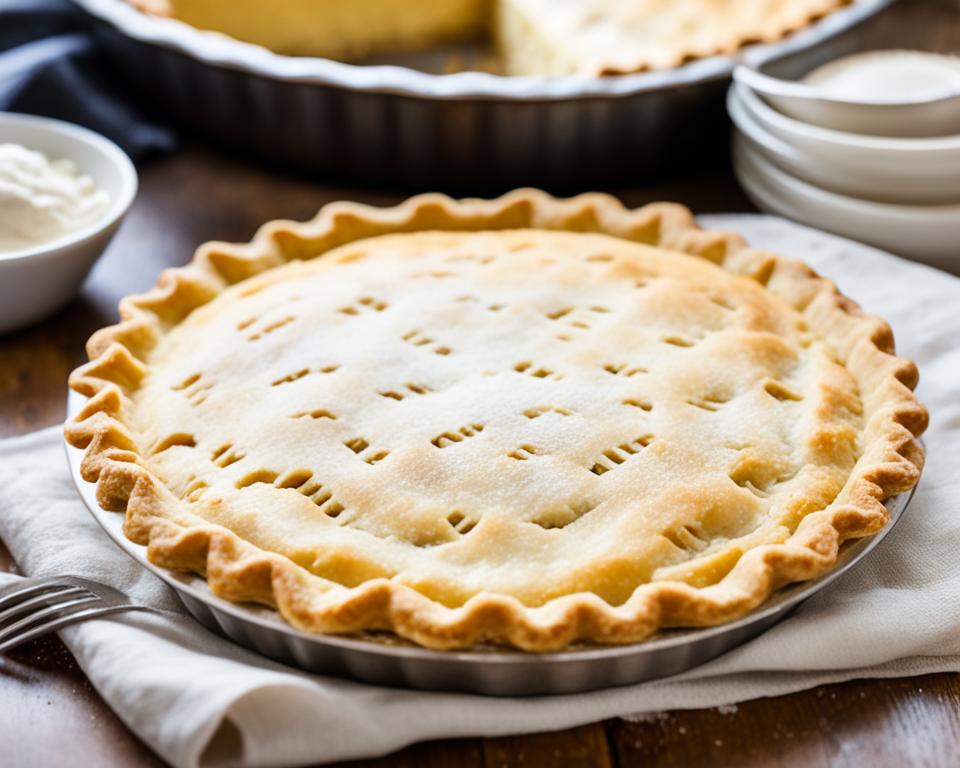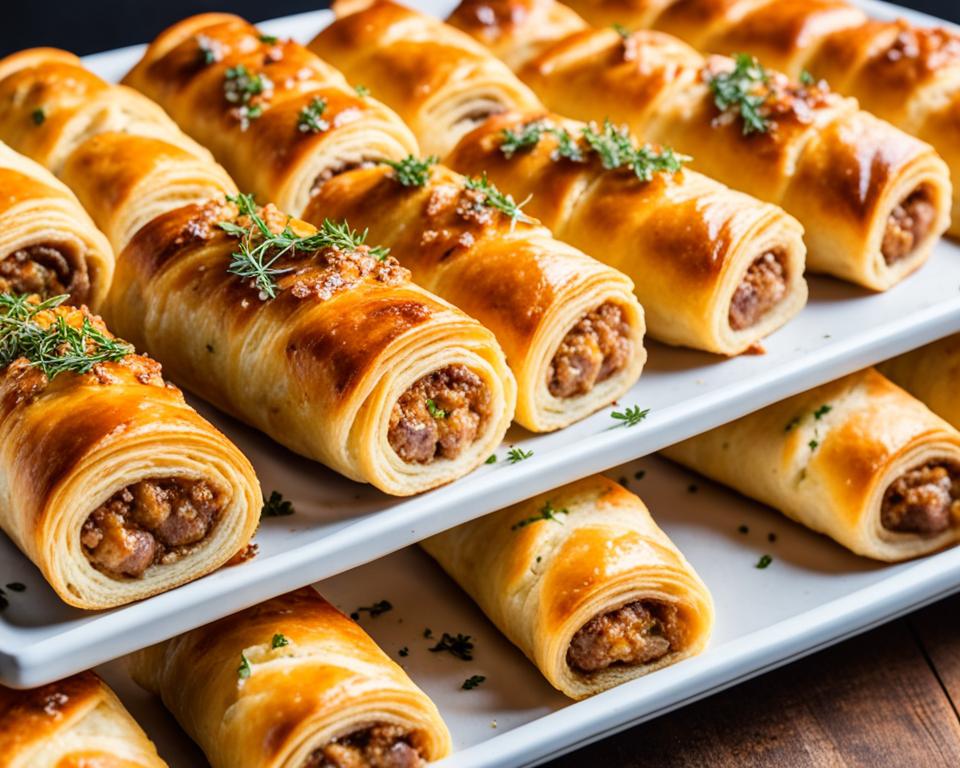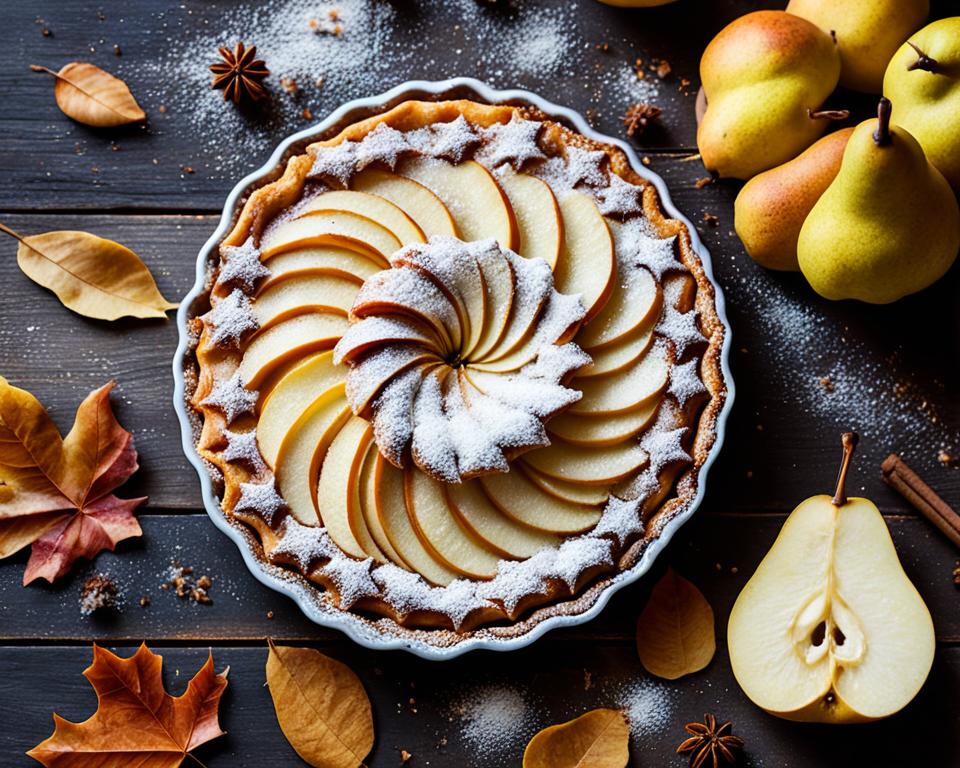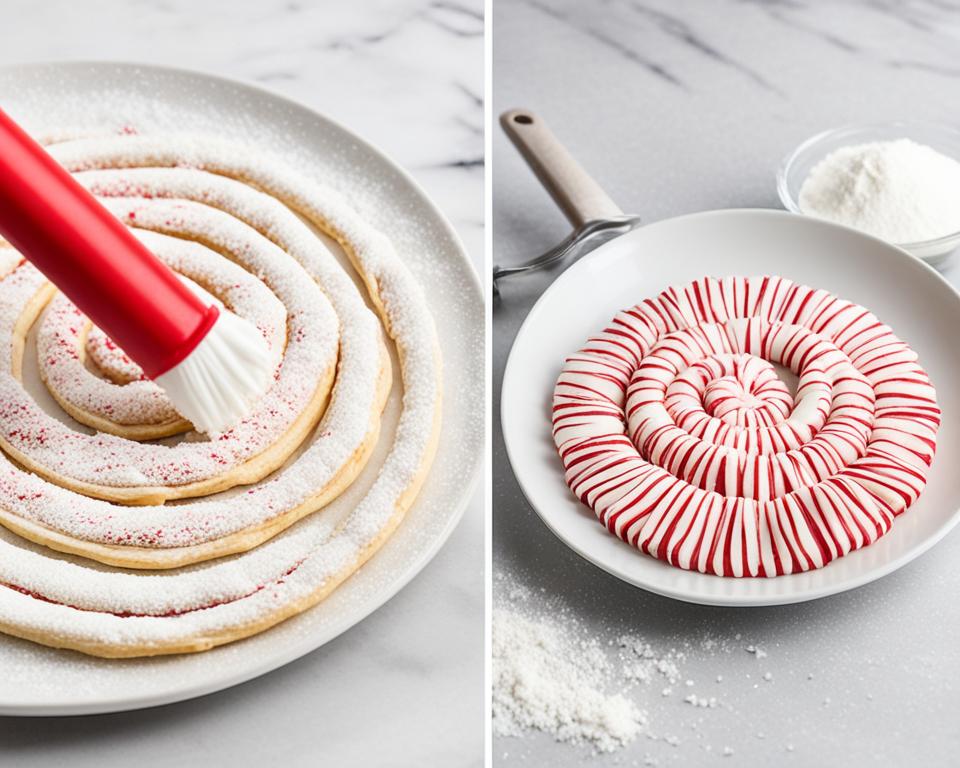Are you ready to take your homemade pies to the next level? Look no further than this perfect flaky pie crust recipe with butter. Whether you’re a seasoned baker or just starting out, this recipe is easy to follow and guarantees a buttery, flaky crust every time.
Made with just a few simple ingredients like all-purpose flour, salt, butter, and ice cold water, this homemade pie crust is the secret to a truly delicious pie. The key to achieving that flaky texture lies in the method of cutting in chilled, diced butter until it resembles coarse crumbs. The dough is then shaped into a disc, wrapped in plastic, and refrigerated for at least 4 hours or overnight to allow the butter to solidify.
Once the dough is chilled, it’s time to roll it out to an 11-inch circle and place it in your pie dish. From there, you can blind bake the crust or fill it with your favorite pie filling and bake according to your specific recipe. The end result? A pie with a perfectly flaky, buttery crust that will have everyone coming back for seconds.
Key Takeaways:
- This flaky pie crust recipe with butter is easy to make and yields delicious results.
- Cutting in chilled, diced butter is the key to achieving a flaky texture.
- Chilling the dough allows the butter to solidify and creates a more tender crust.
- Rolling out the dough to an even thickness is crucial for a uniform crust.
- A well-made pie crust can elevate any pie filling and make the overall pie more enjoyable.
The Importance of a Flaky Pie Crust
A flaky pie crust is the foundation of a delicious pie. It provides structure and adds texture to every bite. A buttery pie crust recipe, like the one discussed here, is preferred by many because it imparts a rich and flavorful taste. This recipe is considered one of the best pie crust recipes due to its consistent results and ability to create light and flaky layers. A well-made pie crust can elevate any pie filling and make the overall pie more enjoyable.
“A pie without a flaky crust is like a beautiful painting without a frame. The crust enhances the pie’s flavors and textures, making each bite a delightful experience.” – Emily, Pie Enthusiast
When it comes to creating a pie, the crust is not just a supporting player but a star in its own right. A perfectly flaky crust adds a satisfying crunch and delicate layers that complement the sweetness or savory goodness of the filling. Whether it’s an apple pie, pumpkin pie, or any other pie variety, the crust sets the stage for culinary excellence.
With the right technique and ingredients, a buttery pie crust can be achieved effortlessly. This tried-and-true recipe, known for its exceptional results, has been a favorite among bakers for generations. It consistently produces a flaky and tender crust that melts in your mouth, complementing the flavors of the filling.
What sets this recipe apart is its attention to detail and the balance of flavors. It combines the richness of butter with the lightness of flakiness, creating a crust that is both indulgent and delicate. The well-incorporated butter brings out its full-bodied flavor, which enhances the overall taste of the pie.
By following this best pie crust recipe, you’ll be able to achieve a golden, flaky crust that is sure to impress even the most discerning of pie enthusiasts.
Why Flaky Crust Matters
A flaky pie crust is more than just a textural delight – it serves a vital purpose in pie baking. The layers created by the butter in the crust act as tiny air pockets, which contribute to its flakiness. These layers add depth to each bite, allowing the flavors of the filling to shine through while still providing a satisfying crunch. Without a flaky crust, the pie may feel heavy and dense, detracting from the overall enjoyment of the dessert.
Tips for Achieving a Flaky Crust
To ensure a perfectly flaky crust, consider the following tips:
- Use chilled, high-quality butter. Cold butter is key to achieving flakiness as it melts in the oven, creating steam that lifts and separates the layers of the dough.
- Avoid over-mixing the dough. Overworking the dough leads to gluten development, resulting in a tough and chewy crust. Mix the ingredients just until they come together.
- Chill the dough before rolling. Allowing the dough to rest and chill in the refrigerator helps solidify the butter and relaxes the gluten, preventing shrinkage during baking.
- Roll the dough evenly and gently. Applying too much pressure or rolling the dough unevenly can compromise its flakiness. Roll from the center outwards, rotating the dough to maintain an equal thickness.
- Keep all ingredients cold. This includes flour, water, and even the rolling pin. Cold ingredients help maintain the ideal temperature for flakiness and prevent the dough from becoming sticky.
By following these steps and using the best pie crust recipe, you can create a flaky and buttery crust that will elevate your pies to new heights. Whether it’s a classic apple pie, a luscious pumpkin pie, or any other fruity or savory creation, the perfect pie crust will be the star of the show.
The Key Elements of a Flaky Pie Crust
| Element | Description |
|---|---|
| Chilled Butter | The use of chilled butter ensures that it remains solid until baked, creating steam and flaky layers. |
| Quality Flour | High-quality all-purpose flour with a higher protein content helps create the structure and texture of the crust. |
| Ice-cold Water | Cold water prevents the butter from melting and maintains the ideal temperature for flakiness. |
| Proper Technique | Using the correct mixing and rolling techniques, as well as chilling the dough, helps achieve the desired flakiness. |
The Role of Flour and Fat in Pie Crust
The main ingredients in a pie crust are all-purpose flour, cold butter, and sometimes vegetable shortening. The choice of flour is important, as high-quality flour with a higher protein content can help baked goods rise higher and stay fresh longer. Cold butter is preferred because its water content converts to steam during baking, creating flaky layers in the crust. Vegetable shortening adds structure and stability to the dough, helping it maintain its shape. The combination of these ingredients in the right proportions is what creates a flaky and tender pie crust.
The Role of Temperature in Pie Crust
Temperature plays a crucial role in creating a perfect pie crust. The key is to keep the butter and other ingredients as cold as possible throughout the preparation process. This is essential to prevent the fats from melting before the crust goes into the hot oven.
The main culprit in compromising the flakiness of the crust is the butter. If the butter melts inside the dough before it gets baked, the crust will lose its desired texture. To ensure the butter remains cold, it is recommended to use cold butter straight from the refrigerator or even keep some of it in the freezer before incorporating it into the dough.
A great tip is to dice the butter into small cubes and place them back in the refrigerator or freezer while preparing other ingredients. By keeping the butter chilled, it remains solid and creates pockets of butter within the dough that contribute to its flakiness.
| Temperature Tips for Perfect Pie Crust | Benefits |
|---|---|
| Use cold butter | Prevents premature melting and ensures flakiness |
| Keep butter in the refrigerator or freezer | Maintains its solid state and creates pockets of butter within the dough |
| Refrigerate the dough | Allows the butter to solidify and maintain the structural integrity of the crust |
To achieve the perfect pie crust, it’s crucial to refrigerate the dough for at least a few hours before rolling it out. This step allows the butter to solidify again and ensures that it won’t melt too quickly during the baking process.
By understanding the role of temperature and implementing these techniques, you’ll be well on your way to creating a scrumptious pie with a flaky, buttery crust.
The Process of Making the Pie Crust
Making a flaky pie crust involves a few specific steps. One method is to use a food processor to combine the flour and fat, ensuring the flour is well-coated with the butter. Another method involves using a pastry cutter to cut the butter into the flour by hand. In both methods, ice water is gradually added to bring the dough together. The amount of water needed may vary depending on factors such as humidity. The dough should be mixed just until it comes together, avoiding overworking it, which can lead to a tough crust.
- Using a food processor: Place the flour and fat in the processor and pulse until the mixture resembles coarse crumbs. Add ice water gradually, one tablespoon at a time, and pulse until the dough starts to come together. Be careful not to overprocess.
- Using a pastry cutter: Place the flour and fat in a bowl. Use a pastry cutter or two knives to cut the fat into the flour until it resembles coarse crumbs. Gradually add ice water, one tablespoon at a time, and mix with a fork until the dough starts to come together.
Tips for Mixing the Dough:
- Keep your ingredients, especially the fat, as cold as possible to prevent them from melting into the dough prematurely.
- Add the ice water gradually and mix just until the dough starts to come together. Be careful not to overwork the dough, as this can result in a tough crust.
- Adjust the amount of water based on factors such as humidity. The goal is to achieve a dough that holds together without being too wet or sticky.
By following these steps, you can create a perfectly flaky pie crust using either a food processor or pastry cutter method.
Tips for Rolling Out the Dough
Rolling out the pie dough requires a few tips and techniques to ensure success. By following these guidelines, you can achieve an even and perfectly rolled dough for your pie.
Lightly Flour the Rolling Pin, Work Surface, and Hands
To prevent the dough from sticking, it’s important to lightly flour the rolling pin, work surface, and your hands. This creates a barrier between the dough and the surfaces, allowing for smooth and easy rolling.
Start from the Center and Work Outwards
When rolling out the dough, begin from the center and move outward in all directions. This technique helps distribute the pressure evenly, ensuring the dough maintains a consistent thickness throughout.
Rotate and Flip the Dough
Between passes of the rolling pin, it’s recommended to rotate the dough and flip it. This helps prevent sticking and allows you to roll the dough into the desired shape. If the dough starts to stick, simply add more flour as needed.
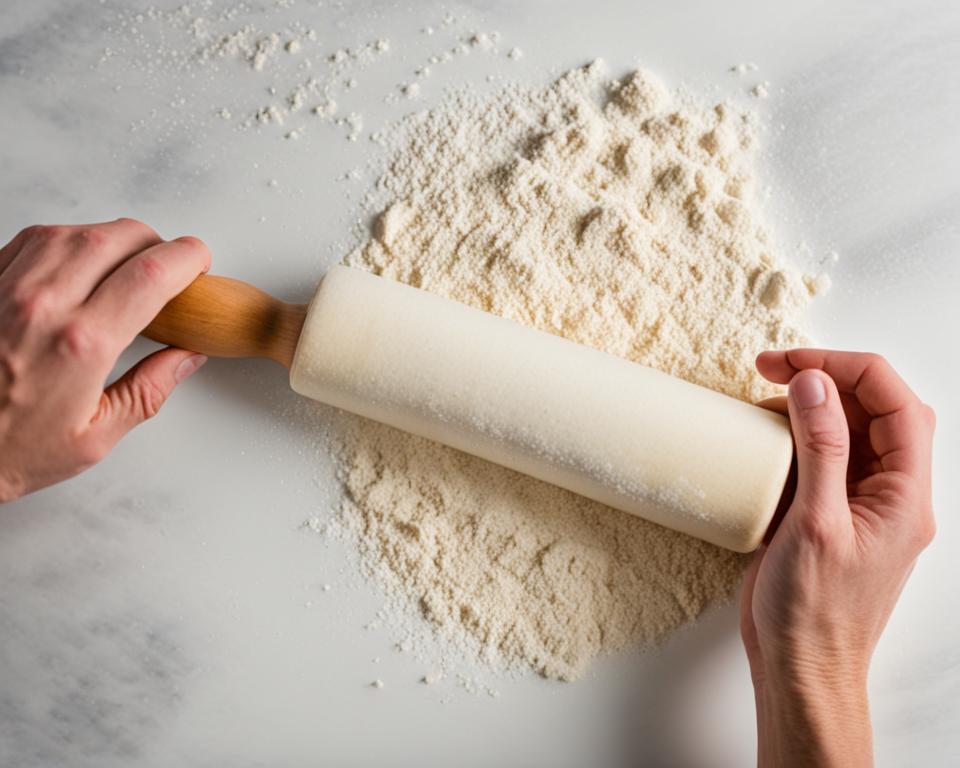
Achieve the Desired Size and Shape
Continue rolling the dough, rotating, and flipping as necessary, until it reaches the desired size and shape for your pie. Whether you’re making a single-crust or double-crust pie, taking the time to roll the dough properly ensures a beautifully baked crust.
To summarize, lightly flouring the rolling pin, work surface, and hands, starting from the center and working outwards, rotating and flipping the dough, and achieving the desired size and shape are key tips for successfully rolling out pie dough. Incorporate these techniques into your pie-making process to create a visually stunning and delicious pie crust.
Storing and Freezing the Pie Dough
Pie dough is versatile and can be made in advance, allowing for convenient pie-making whenever the craving strikes. To ensure your dough stays fresh and ready to use, it’s important to store it properly. Follow these tips for storing and freezing your pie dough:
Refrigerating Your Dough
To store your pie dough in the refrigerator, tightly wrap it in plastic wrap to prevent drying out. Place the wrapped dough in the refrigerator and keep it chilled for up to 3 days.
Freezing Your Dough
If you’re not planning to use your pie dough within 3 days, freezing is a great option for long-term storage. Wrap the dough tightly in plastic wrap to protect it from freezer burn. For added freshness, you can also place the wrapped dough in a freezer bag or airtight container. Frozen pie dough can be stored in the freezer for up to 3 months.
Thawing Your Frozen Dough
When you’re ready to use your frozen pie dough, it’s important to thaw it properly to maintain its integrity. The best method for thawing is to transfer the wrapped dough from the freezer to the refrigerator and let it thaw overnight. Slowly thawing the dough in the refrigerator prevents it from becoming too soft or sticky.
Once thawed, the dough can be rolled out from its frozen state or brought to room temperature for a few minutes before rolling. Be sure to handle the dough gently to maintain its flakiness and delicate texture.
With the ability to refrigerate or freeze your pie dough, you can always have fresh and homemade pies on hand. By following these storage tips, you’ll be ready to bake delicious pies at any time.
Recipe Variations and Pie Ideas
The flaky pie crust recipe with butter opens up a world of possibilities for creating delicious pies with various fillings. From classic favorites to innovative creations, there are endless options to explore. Here are a few popular variations and pie ideas to inspire your next baking adventure:
1. Apple Pie
The combination of a buttery flaky crust and the sweet-tart flavor of apples makes apple pie a timeless classic. Whether you prefer a traditional double-crust pie or a rustic galette, the homemade crust will perfectly complement the juicy apple filling. Serve it warm with a scoop of vanilla ice cream for the ultimate comfort dessert.
2. Pumpkin Pie
No Thanksgiving feast is complete without a slice of velvety smooth pumpkin pie. The buttery crust provides a delightful contrast to the creamy pumpkin custard filling. Enhance the flavors with warm spices like cinnamon, nutmeg, and cloves. Sprinkle some whipped cream on top for an extra touch of indulgence.
3. Cherry Pie
Indulge in the deliciousness of sweet, juicy cherries enveloped in a flaky pie crust. Whether made with fresh cherries during the summer months or with frozen cherries all year round, cherry pie is a crowd-pleaser. The crust can be used for a lattice top or a crumb topping, adding texture and visual appeal to this delightful dessert.
4. Fruit Galettes
Give your pies a rustic twist by making individual fruit galettes. These free-form pastries are filled with an assortment of seasonal fruits such as berries, peaches, or pears. The buttery flaky crust acts as a delicious vessel for the juicy fruit, resulting in a dessert that is both elegant and easy to make.
| Pie Variation | Key Ingredients | Preparation |
|---|---|---|
| Apple Pie | Apples, cinnamon, sugar, lemon juice | Prepare the pie crust. Mix the sliced apples with sugar, cinnamon, and lemon juice. Fill the crust and bake until golden brown. |
| Pumpkin Pie | Pumpkin puree, evaporated milk, eggs, spices | Make the pie crust. Whisk together the pumpkin puree, milk, eggs, and spices. Pour into the crust and bake until set. |
| Cherry Pie | Cherries, sugar, cornstarch, almond extract | Prepare the crust. Toss the cherries with sugar, cornstarch, and almond extract. Fill the crust and bake until bubbly and golden. |
| Fruit Galettes | Assorted fruits, sugar, lemon zest, cornstarch | Shape individual galettes with the pie crust. Toss the fruits with sugar, lemon zest, and cornstarch. Fill each galette and fold the edges. Bake until golden and juicy. |
Experiment with different combinations of fillings and crust designs to create your own signature pies. From berry pies to custard-based creations, the flaky pie crust recipe with butter will enhance the flavors and textures, ensuring a delightful dessert experience every time.
Conclusion
The perfect flaky pie crust recipe with butter is the key to creating exceptional homemade pies. By following the steps outlined in this recipe, you can easily achieve a buttery and flaky crust that will impress your family and friends. From carefully selecting high-quality ingredients to maintaining the right temperature throughout the process, every detail contributes to the success of your pie crust.
With this recipe, you can confidently embark on your pie baking journey and enjoy the satisfaction of a perfectly made crust. Whether you’re making a classic apple pie, a luscious pumpkin pie, or a tangy cherry pie, this versatile crust will complement any filling with its flaky texture and rich flavor.
So, next time you crave a homemade pie, don’t settle for anything less than perfection. Give this recipe a try and experience the joy of biting into a slice of pie with a delicious and flaky crust – the hallmark of a truly outstanding dessert.
FAQ
What are the main ingredients in a pie crust?
The main ingredients in a pie crust are all-purpose flour, cold butter, and sometimes vegetable shortening.
Why is temperature important when making a pie crust?
Keeping the butter and other ingredients as cold as possible is important to prevent the fats from melting before the crust hits the hot oven, ensuring a flaky crust.
What are some tips for rolling out the pie dough?
Lightly flour the rolling pin, work surface, and hands to prevent sticking. Start from the center and work outwards, rotate and flip the dough between passes, and add more flour if needed.
Can the pie dough be made in advance?
Yes, the pie dough can be tightly wrapped in plastic wrap and refrigerated for up to 3 days or frozen for up to 3 months.
What types of pies can be made with this crust?
This pie crust recipe can be used for a variety of pies, including apple, pumpkin, cherry, and fruit galettes.

